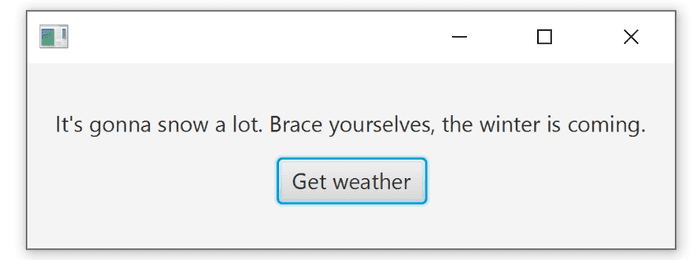
- JavaFX Tutorial: Getting started
- JavaFX Tutorial: Hello world
- JavaFX Tutorial: FXML and SceneBuilder
- JavaFX Tutorial: Basic layouts
- JavaFX Tutorial: Advanced layouts
- JavaFX Tutorial: CSS Styling
- JavaFX Weaver: Integration of JavaFX and Spring Boot
JavaFX & Spring
When working with Java these days, you rarely work just with plain Java. In most of the projects, people usually use the Spring Framework or Spring Boot, respectively. It has a lot of advantages and many useful features.
However, when you're developing JavaFX applications, there is no easy way to integrate it with Spring. The integration does not work out of the box as JavaFX applications have their own lifecycle and take care of instantiating controllers.
JavaFX-Weaver
JavaFX-Weaver is a project by Rene Gielen, which aims to integrate Spring and JavaFX. The setup is, fortunately, not that hard.
Getting started
Let's try with a plain simple Spring Boot project, and let's try to integrate JavaFX. You can generate a new project using Spring Initializr. You don't need to add any dependencies here. If you want to avoid getting into setting up JavaFX as a dependency, select a Java version pre-11 as it still contains JavaFXas a part of the JDK.
Adding a controller
We'll need a controller and a companion .fxml view to be able to test that our application works properly both with Spring and JavaFX. Let' create a controller first. Let's keep it empty for now.
public class MyController {
}Adding a view
Now we need a .fxml file, which will be used with our controller as a view. We'll place it in the resources folder. For the integration to work properly, it is necessary to create it in the resources folder, but in a directory structure matching the package where is our controller.
For example, let's assume our controller is in package com.vojtechruzicka.javafxweaverexample. The .fxml file needs to be placed precisely here:
src\main\resources\com\vojtechruzicka\javafxweaverexampleLet's call our file main-scene.fxml.
Dependencies
If you are using plain Spring, the setup is little different, but for Spring Boot you just need to add the following dependency to your pom.xml file:
<dependency>
<groupId>net.rgielen</groupId>
<artifactId>javafx-weaver-spring-boot-starter</artifactId>
<version>1.3.0</version>
</dependency>Or this one if you are using Gradle:
implementation 'javafx-weaver-spring-boot-starter:1.3.0'Spring Boot Application class
When we generated our base Spring Boot application, the main application class was also generated for us. It is the class annotated with @SpringBootApplication, which is used as an entry point to run the whole app.
But wait! JavaFX also has its main application class, which is used as an entry point for starting JavaFX applications.
That's confusing. So which one should be actually used to run our app, which is both Spring Boot and JavaFX?
We'll still use our @SpringBootApplication with a slight modification. Instead of running the Spring app directly, we'll use it to run our JavaFX app. And the JavaFX Application will be responsible for properly starting the Spring application context and integrating everything together using JavaFX Weaver.
We need first to make sure that the Spring Boot app launches our JavaFX app.
import javafx.application.Application;
import org.springframework.boot.autoconfigure.SpringBootApplication;
@SpringBootApplication
public class SpringBootExampleApplication {
public static void main(String[] args) {
// This is how normal Spring Boot app would be launched
// SpringApplication.run(SpringBootExampleApplication.class, args);
// JavaFxApplication doesn't exist yet,
// we'll create it in the next step
Application.launch(JavaFxApplication.class, args); }
}JavaFX Application class
Now our @SpringBootApplication is calling JavaFxApplication, which does not exist yet. Let's create it now.
public class JavaFxApplication extends Application {
private ConfigurableApplicationContext applicationContext;
@Override
public void init() {
String[] args = getParameters().getRaw().toArray(new String[0]);
this.applicationContext = new SpringApplicationBuilder()
.sources(SpringBootExampleApplication.class)
.run(args);
}
}When the JavaFX initializes, it creates a new application context based on the configuration in our SpringBootExampleApplication - the main class of the Spring Boot application, which we modified in the previous step.
Now we have a Spring Boot application running with our new application context. But we need to make sure the context is properly closed when the JavaFX application terminates. For example, when you close the window. Let's handle this now.
@Override
public void stop() {
this.applicationContext.close();
Platform.exit();
}Now the last part is to actually create a new window (Stage) and show it.
@Override
public void start(Stage stage) {
FxWeaver fxWeaver = applicationContext.getBean(FxWeaver.class);
Parent root = fxWeaver.loadView(MyController.class);
Scene scene = new Scene(root);
stage.setScene(scene);
stage.show();
}This is where Fx Weaver comes into play. We need to obtain its bean from the application context and then use it to load our FXML.
Spring-managed controllers
Traditionally we would create our Stage using FXMLLoader, which would load the FXML file and create a Controller instance declared in it for us.
FXMLLoader loader = new FXMLLoader();
URL xmlUrl = getClass().getResource("/main-scene.fxml");
loader.setLocation(xmlUrl);
Parent root = loader.load();
Scene scene = new Scene(root);
stage.setScene(scene);
stage.show();So why are we using FX Weaver instead? What's problematic is that FXMLLoader creates the controller instance for us. That means it is not created and managed by Spring. Therefore we cannot use dependency injection and other Spring goodies in our controllers. And that's why we introduced Spring in our JavaFX in the first place!
But when FX Weaver creates the controller for us, it creates it as a Spring-managed bean, so we can fully utilize the features of Spring.
Enabling Spring for the controller
The first thing we need to do is to annotate our existing JavaFX controller with @Component so it gets recognized and managed by Spring. Next, we need to add @FxmlView annotation, so it gets recognized by FX Weaver.
import net.rgielen.fxweaver.core.FxmlView;
import org.springframework.stereotype.Component;
@Component@FxmlView("main-stage.fxml")public class MyController {
}Note the parameter of @FxmlView("main-stage.fxml"). It specifies the name of your .fxml file, which should be matched with the controller. It is optional. If you don't specify it, Fx Weaver will use the name of the controller class as the file name with .fxml extension. The FXML file needs to be in the same package as the controller, but in the resources folder.
Making sure everything works
Now let's make sure everything works and integrates nicely. Let's run our @SpringBootApplication with its main method. You should see a simple window with a label, nothing fancy.
Ok, that means that the application runs, but we didn't really do anything Spring-specific in our controller. No dependency injection or anything. Let's try that now.
Adding a Service
To make sure Spring integration works properly, let's create a new Spring-managed service. Later, we'll inject it in our controller and use it there.
import org.springframework.stereotype.Service;
@Service
public class WeatherService {
public String getWeatherForecast() {
return "It's gonna snow a lot. Brace yourself, the winter is coming.";
}
}Nothing special, it's a service for weather forecasting, which is not very dynamic right now, but it will be enough for our example.
Injecting the service
Now let's inject our new service into our existing controller. It's the usual Spring stuff, nothing special here.
@Component
@FxmlView("main-stage.fxml")
public class MyController {
private WeatherService weatherService;
@Autowired public MyController(WeatherService weatherService) { this.weatherService = weatherService; }}Loading the forecast
Now we need to load the data from our service somehow. Let's change our FMXL view, so:
- There is a button which loads the data from
WeatherServiceon click - The loaded data is shown in a label
<?xml version="1.0" encoding="UTF-8"?>
<?import javafx.scene.control.*?>
<?import javafx.scene.layout.*?>
<VBox xmlns="http://javafx.com/javafx"
xmlns:fx="http://javafx.com/fxml"
fx:controller="com.vojtechruzicka.javafxweaverexample.MyController"
prefHeight="100.0" prefWidth="350.0" spacing="10" alignment="CENTER">
<Label fx:id="weatherLabel"/> <Button onAction="#loadWeatherForecast">Get weather</Button></VBox>Note the fx:id="weatherLabel" identifier, we'll use it to get access to this label in our controller so that we can change its text.
onAction="#loadWeatherForecast" is a method on our controller, which should be called when the button is clicked. We still need to add it to the controller. Let's do it now.
Controller logic
The last step is to change our controller, so it reacts to the button click in the view, loads weather forecast data, and sets it to our label.
So we need a reference to the label from our view so that we can change its text. We need to select its name to match the fx:id="weatherLabel".
@FXML
private Label weatherLabel;Now we need to add the method, which is called when the button is clicked - onAction="#loadWeatherForecast".
public void loadWeatherForecast(ActionEvent actionEvent) {
this.weatherLabel.setText(weatherService.getWeatherForecast());
}In this method, we take the weather forecast from the service and set it to our label, which we defined before.
If you run the app now, after you click the button, it should load the current weather forecast.

Accessing components from view
Same as in plain JavaFX, you can declare components from view to be injected to your controller, so you can interact with them.
@FXML
private Label weatherLabel;We already saw this works well. You just need to be careful about timing. Our controller is annotated by @Component, so it is a regular Spring-managed bean. It means it is instantiated by Spring when the application context starts and all the dependencies are injected. However, the weaving by FX Weaver happens later. And during this weaving, the component references are injected.
This has one implication. In your constructor and @PostConstruct you can already work with Spring injected dependencies as usual. However, be aware that during this time, references to components from the view are not yet available and are therefore null.
Conclusion
JavaFX Weaver provides a nice and easy way to integrate Spring with JavaFX applications. It is otherwise not so straightforward as JavaFX manages its own lifecycle and lifecycle of its controllers. JavaFX Weaver makes the integration possible and quite straightforward, so you can finally use all the cool features of Spring even with JavaFX.
- JavaFX Tutorial: Getting started
- JavaFX Tutorial: Hello world
- JavaFX Tutorial: FXML and SceneBuilder
- JavaFX Tutorial: Basic layouts
- JavaFX Tutorial: Advanced layouts
- JavaFX Tutorial: CSS Styling
- JavaFX Weaver: Integration of JavaFX and Spring Boot

